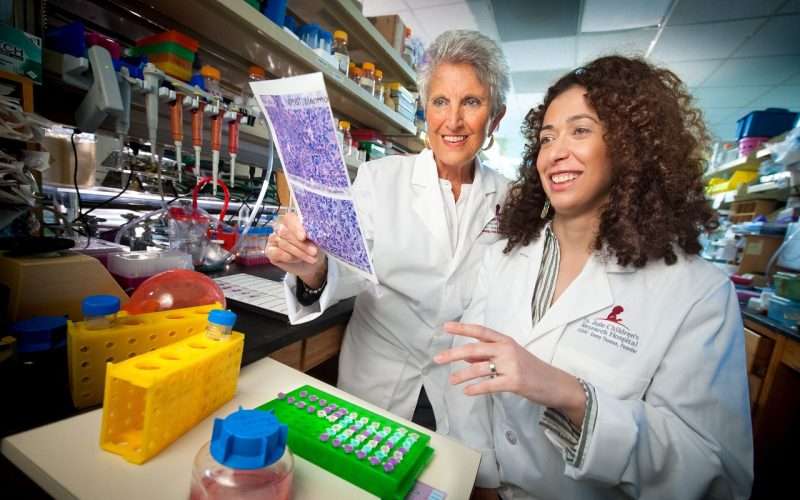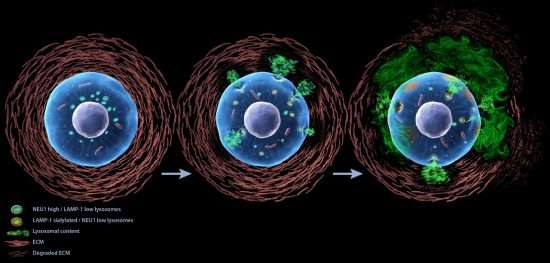Tumors hijack export pathway in cells to resist chemotherapy and fuel disease progression

St. Jude Children's Research Hospital scientists have discovered how an aggressive tumor of the muscle and soft tissue hijacks an export pathway in cells to lay the groundwork for cancer progression and resistance to chemotherapy. The research appears today in the journal Science Advances.
Working in the laboratory, investigators also demonstrated in principle that medication can be used to help restrain the pathway, blocking cancer's spread and restoring tumor vulnerability to chemotherapy.
The work involved the neuraminidase 1 (NEU1) enzyme. NEU1 is found in specialized compartments called lysosomes that cells use for digestion and recycling. NEU1 helps to restrain a biological pathway called lysosomal exocytosis that cells use to repair their outer membrane and selectively export materials from lysosomes. Loss of NEU1 disrupts the process, leading to the uncontrolled discharge of harmful lysosomal contents into the cells' microenvironment, severely affecting tissue and organ function.
Such excessive lysosomal exocytosis is responsible for symptoms of a rare, severe and inherited disorder called sialidosis that affects children and adolescents. In this study, St. Jude investigators identified a role for NEU1-regulated lysosomal exocytosis in cancer-drug resistance and tumor invasiveness, specifically in sarcomas that have spread. Soft tissue sarcoma is a cancer that is identified in about 12,000 children and adults annually in the U.S. The disease kills about 4,700 U.S. residents annually.

"This study helps to answer a central question of cancer biology, which is how tumor cells become invasive and drug resistant," said corresponding author Alessandra d'Azzo, Ph.D., who holds the Jewelers For Children Endowed Chair in Genetics and Gene Therapy and is a member of the St. Jude Department of Genetics. "We show that aggressive forms of sarcomas systematically down-regulate NEU1 expression to their advantage."
The discovery stemmed from an observation in mice lacking the Neu1 gene. "The best discoveries are often serendipitous, and this began with a serendipitous observation," d'Azzo said. "We noticed that the connective tissue in these mice was behaving in an abnormal way, exhibiting unusual proliferative and migratory capacity. That raised the question of whether the same process helps tumor cells invade surrounding tissue and become metastatic."
NEU1 restrains lysosomal exocytosis by acting on and regulating the supply of a protein named LAMP1. LAMP1 is part of the lysosomal membrane. Lysosomes need LAMP1 to dock to the cell membrane. That docking sets the stage for the lysosomal and cell membranes to fuse and release the lysosome's cargo into the microenvironment of the cell.
Researchers in this study screened human sarcoma cells and found that as some tumors advanced and became more aggressive, NEU1 production declined and LAMP1 increased. These features were particularly evident in hard-to-treat pleomorphic sarcomas. In one case, NEU1 was detectable in a tumor at diagnosis, but absent in a tumor at relapse. Meanwhile, LAMP1 levels in the tumors increased between diagnosis and relapse.
Working in human sarcoma cells growing in the laboratory and in specially bred cancer-prone mice, researchers found that reduced NEU1 was associated with faster tumor growth and spread.
Investigators showed that tumors can use the same pathway to resist chemotherapy by sequestering drugs in lysosomes and then purging them. "Due to their chemical properties, many widely used chemotherapeutics, including cisplatin, doxorubicin and vincristine, can get trapped in lysosomes," d'Azzo said. "This is the first report that lysosomal exocytosis may play a role in drug resistance."
Researchers also demonstrated that blocking lysosomal exocytosis helped to restore tumor cell sensitivity to chemotherapy, specifically to the drug doxorubicin. The release of lysosome-trapped doxorubicin by excessive lysosomal exocytosis declined in tumor cells treated with the hypertension drug verapamil, and sensitivity to chemotherapy increased. That is likely because verapamil blocks cells from importing calcium. An influx of calcium is necessary for lysosomes to complete the export process. "This highlights a possible new target for combination drug therapy," d'Azzo said.
More information: E. Machado et al. Regulated lysosomal exocytosis mediates cancer progression, Science Advances (2015). DOI: 10.1126/sciadv.1500603














